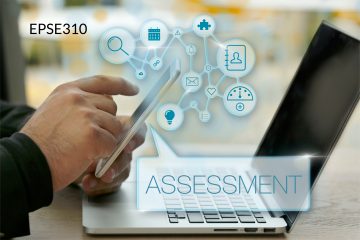As part of any study into current assessment practices, you will want to explore the potential of integrating digital technologies, including multi-modal creation/communication tools and/or student response systems (SRS), into your teaching.

MultiModal creation and communication
When creating an inclusive learning environment and planning for all learners (Universal Design for Learning), it is essential we provide opportunities for voice and choice. If the use of multi-modal response is essential for some learners, then it is good for all learners! Consider providing access to tools that allow your students to share their ideas using visuals (including video, photos, drawing), text and audio. You might try:
A couple of alternatives for student representation and expression as assessment of and for learning:
- Showme and Explain Everything are in a class of apps called ‘digital whiteboards‘ or whiteboard style apps and are great for formative assessment and even for student projects and presentations allowing voice narration, video, images, drawing and typing. I can ask a student to ‘showme’ what they know by asking them to annotate an image, share a video of completing a problem etc. (Students can ‘annotate’ or draw on an image as they record their voice. also allows for scientific notation) * free to download so students can use on their own devices if they wish – NOT Canadian housed so informed consent is important – and/or use of school owned devices with no account sign up.
- Flip Grid – creating and sharing videos in a Microsoft learning tools environment (NB: many coast metro school districts use FlipGrid and other MSoft tools) or set up your own free teacher account, add students (using first name only or avatar names to protect privacy) and provide students with a join code/QR code (check for indiv school/district permissions). Allows the teacher to moderate posts!
- Concept mapping is a powerful tool for illustrating complex links between ideas (be they images or text). Many softwares allow for hyperlinking and embedding images and video. Mindmup is a browser based application that allows co-creation of a concept map across time and space (NB: co-creation seems to now be a paid level of access – I’m trying to find another option… Schools/Districts using Google Classroom will have co-creation access)
- ePortfolios provide rich opportunities for students to select, evaluate and share products of, and reflections on, their learning. Freshgrade is a Canadian housed/FIPPA compliant platform teachers can access for free. Several BC school districts (and beyond) have paid accounts so students can be ‘auto enrolled’. Parents can also be given access. MyBlueprint has also being adopted in some local school districts – All About Me for K-6 and Education Planner for 7 – 12.
All-Class Response and Student Response Systems (SRS)
Educators and researchers have long considered the benefits of students actively engaging in the classroom and how this can lead to gains in student learning. One way to achieve such engagement is by effectively incorporating all-class response or a student response system (SRS) as a part of your classroom assessment approach. It is important to consider the benefits and the potential drawbacks of various systems available to you as a K-12 educator in order to select one that meets your (and your students’) needs.
Be sure to keep in mind that the efficacy of any student response system depends on the quality of the questions and how you use the system. You will learn, as part of your course work, how to develop effective selection and supply questions (multiple choice). This work will be helpful in selecting an SRS and constructing a poll or quiz for formative or summative assessment. While these questions should not form the basis of your overall assessment, they can be one piece of the puzzle and can support formative (and sometimes summative) assessment. In particular, as discussed, using an effective discussion strategy will increase the value of an SRS.
Some issues to consider when engaging your students with digital technologies and online learning:
- BYOD and Access – bring your own device – Are there policies in place in my school or rules in my classroom to consider? What about students who do not have access to a device? When pairing or grouping students and expecting one device in a group, do you know if the student who owns that device is willing to share it OR are there devices in the school you can borrow? What impact does it have on students when they do not have the same access as others?
- FIPPA – Freedom of Information and Privacy Protection act – Students data should not be shared on non-Canadian housed servers… Am I protecting students data privacy? Do I have necessary permissions or consent? Am I engaging my students in critical digital literacy discussion around privacy & safety in a broader sense? School Districts will have policies in place that meet the informed consent requirements of FIPPA. Be aware of local policies. (See this helpful guide from BCTF to support teachers and parents)
All class response (vs. hands up/volunteers), including the use of a digital student response system (SRS) can lead to greater student engagement. Read this article in Educause describing how the efficacy of assessments and increases in student learning are achieved when an SRS is coupled with socio-constructivist methods. The use of these systems along with student discussion, peer teaching and pair share can also lead to greater student satisfaction and engagement. All class response is in keeping with a large body of research supporting more inclusive approaches to assessment.
Chapter 4 of Leahy and Williams’, Embedding Formative Assessment, makes a case of ‘all student response’ and limiting teacher questions to only those that propel learning. This book is a valuable addition to any teacher’s library and clearly links theory with practical strategies and relevant advice. (UBC Library has a copy)
The notion that engaging the ‘backchannel’ during lectures and classes can add a more active component to what are sometimes more passive forms of teaching is taking hold with the growth in BYOD (bring your own device) in secondary and post-secondary classrooms. By allowing students to voice their ideas or ask questions during a lecture or class work period using electronic tools such as those built into most learning management systems and widely available free online, you are providing opportunities for students to ask just-in time questions, share thoughts and connect with one another; potentially increasing student engagement and learning. These potential benefits come with ‘management’ needs and requires the development of a set of expectations in the classroom that student can follow. This can take time, usually involves some trial and error but is a risk that may be worth taking when one considers the increase in student agency that can result from the moderate risk. I modeled Mentimeter
The value of anonymous responses… We know that adolescent learners appreciate, or some would even say require, the opportunity to participate anonymously. Due to their sometimes heavy reliance on peer approval, students at this age can be reluctant to share their views orally. For this reason, employing an SRS can give voice to quieter learners and generate more honest responses. Of course, anonymity comes with drawbacks so be sure to consider the following:
- How are responses published, shared or viewed?
- Can I moderate responses? (i.e. can I see them and approve them before they are ‘live’ to the students)
- Can students change their responses or provide multiple responses?
- Can I archive or track student responses in some way? (do I need to?)
- How will I respond if a student posts an inappropriate response?
- How can I create a class climate the promotes risk taking and accountability?
- consider small group response vs. individual response – students discuss their ideas and, using one device for the group, record their response… this can lessen the potential for inappropriate responses especially where the teacher is actively engaged in/with the class by circulating and checking in.
Student Response Systems: getting started with resources on the Scarfe Digital Sandbox
- Mentimeter – polling software that allows for various types of response and graphical representations (plot graphs, bar graph, word cloud, tiled short answer response)
- Plickers – all you need are free printable scan cards, a teacher account and one mobile device to record and track responses
- iClickers – a Mac and PC set are available on loan in the Education Library
- Poll Everywhere – students answer poll questions using browser, mobile app or text response
- Socrative – create a class account to track responses, students answer using browser or mobile app
- Answer Garden – instantly generates a word cloud of responses, no account needed
- Kahoot – gameify learning in your classroom with ‘Kahoots’
- Padlet – this multi-modal response digital wall is great for brainstorming, checks for understanding and formative assessment (and now includes ability to add audio and drawing in addition to text, hyperlinks, video, images)
Here’s a Student Response System Comparison Chart for an at a glance view of each of the above systems.
Download this handout for more info and some links to research about Student Response: Sandbox_iClicker_Mar2015 update
Visit the Scarfe Digital Sandbox Resource tab and click on ‘assessment‘ for more digital tech integration options for engaging and assessing your students. Visit the Designing Learning Blog for templates and resources to support planning with assessment in mind.
From our lecture:
In EPSE 310, Assessment and Learning in the Classroom, you are learning about the principles and practices for effective, inclusive high quality classroom assessment. You will also become familiar as you continue to prepare for practicum and as you teach, with the BC Ministry document on Assessment and Reporting
A few resources you may find of value (further links in post below):
- Slides from our session Dawydiak EPSE 310 Secondary Jan 26 2020(1)
- Burning Questions and my attempt at responses from the sessions
- MYEd BC – find out how/if you will gain access – use varies across districts but typically used for attendance, class list, IEPs, grade book, reports
- Planning Templates: Learning Design Blog UBC Teacher Education
- Rubrics:
- Competency based assessment tools from Jennifer Munoz SD57 Prince George – a growing collection of cross-curricular and subject specific assessment resources for each of grades K through to 12.
- Rubric and unit plan examples from Dr. Jennifer Katz, UBC, author of EnSouling our Schools
- Single Point Rubrics from Jennifer Gonzalez
- (what is with all these Jennifers and their practical brilliance :D?)

